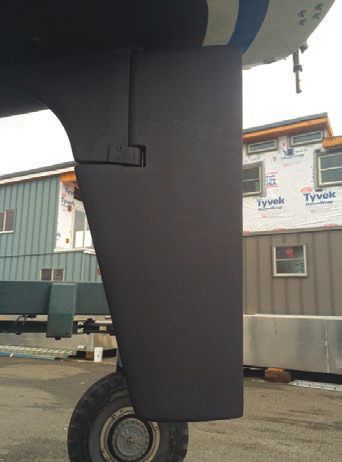When the surprise of a bad rudder comes to light, there’s only one direction to go — forward
Issue 149: March/April 2023

On its deathbed, Yahtzee’s condemned original rudder showed signs of wear and moisture.
I have to start this story with a few warnings. Your rudder matters. Don’t take care of it and you may be inviting disaster. Disregard key warning signs and you may become a desperate sailor trying to lash a piece of cabin sole to your spinnaker pole or attempting to steer with a web of lines and a bucket, or towing a drogue.
Don’t be that sailor. Take care of your rudder and it will take care of you.
My typical steadfast optimism usually precludes me from being such a brash bearer of the negative or trying to drum up fear, but rudder failure stories are all too common and seemingly becoming more so. And I can’t help but think that our 1984 Grand Soleil 39, Yahtzee, might have joined that cadre had we not discovered a problem with our rudder and fixed it immediately instead of letting it sit.
When it comes to rudders, the bottom line is that far more boats — especially old ones — have issues than their owners are aware of, and I can now be added to that group of boat owners. The cautionary tale starts here.
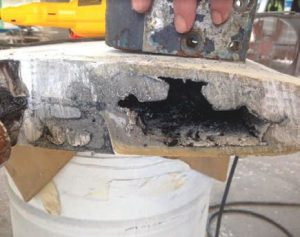
As expected, a crosscut of the rudder revealed that it was indeed hollow.
The Discovery Phase
A couple thousand miles were put behind our rudder in the spring and summer while sailing from the San Juan Islands down to the Columbia River and up to Portland, Oregon, then back north with the Pacific Northwest Offshore Race to Victoria, British Columbia, before circumnavigating Vancouver Island. All the while, we began to notice a small amount of salt water collecting behind our engine. But where was it coming from?
After several intense sessions of boat yoga, I found a small weep coming through the fiberglass above the skeg near the rudder tube. Accordingly, I scheduled a haulout in Seattle immediately and we pointed Yahtzee’s bow south. What I naively expected to take a week or 10 days then morphed into a nearly two-month-long skeg and rudder makeover that involved many hours, lots of fiberglass work, and a hefty bill to match.
The rudder portion of the saga began when I noticed water dripping from it days after a surveyor tapped it during haulout to see if any soft or delaminated spots could be found. It checked out fine then, and had for the previous four years that we’d owned the boat.
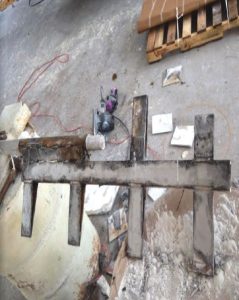
Though the rudder was bad, the stock and internal grid were still usable.
There were no clear signs as to where the moisture was coming from and when we took a grinder to some suspect areas next to the collar that attaches the rudder to the skeg, we didn’t find anything. Before dropping the rudder to work on the skeg issues, which is an entire story in and of itself, we ground down the leading edge of the rudder and found a hairline crack in the fiberglass. That was it.
We then dropped the rudder and laid it on a pallet while the skeg repair commenced. Shortly after, I moved the rudder and thought I heard water sloshing around inside. I could hardly believe what I was hearing, so I moved it a few more times and sure enough, the rudder sounded full of water. Wielding a drill and quarter-inch bit, I drilled a hole in the bottom of the fin, tipped it up, and watched in absolute horror as thick, black water oozed out and created a large puddle on the cement.
Standing over the rudder with drill in hand, I didn’t know if I should scream, cry, vomit, or faint. This was not good, and certainly not what I imagined when we found the crack. But what ended up coming from it all is an immense appreciation for our rudder, how to go about fixing and caring for it, and what I can do to keep it in top shape.
The Decision Phase
The full gravity of our situation struck me while standing next to our rudder with our fiberglass guy, Ethan, listening to his immediate and blunt assessment: “You’re lucky. You could have easily lost this thing offshore. I bet it’s hollow.”
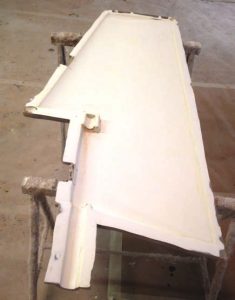
The initial section of the new Grand Soleil 39 rudder mold is crafted in
the shop.
That hit me hard because despite regular checks when hauling out, I had no idea something was amiss. As a full-time cruising family with two young boys aboard, we made Yahtzee our home, and it pained me to think I might have been putting us in harm’s way with a bad rudder that had gone undetected. From that point on, I was determined to make everything better than it ever had been. No matter the cost.
Making it better meant this wasn’t a project I was willing to tackle alone, so I decided to get quotes for fixing the rudder in Seattle or getting a new one made elsewhere. Surprisingly, through this process I came to learn that in many instances, getting an existing rudder repaired is comparable in cost to having a new rudder custom built. And it’s far more bulletproof, because fixing a bad rudder is a complicated science that if not done properly, can turn into a massive failure later.
Going with a new rudder ended up being the best route for our situation, as a repair was quoted at $2,850 and a new rudder came in at $3,000, plus $600 for shipping to and from Florida. The decision seemed like a no-brainer, and when Ethan said he’d rather condemn the old rudder than touch it, I knew we were all in on a new one. Essentially, trying to fix what we had would be a waste of time and money.
The Fix-it-Now Phase
Ethan recommended Foss Foam Products, which has hundreds of rudder molds at its Florida facility. Had a Grand Soleil 39 been one of them, it would have reduced the price of our new rudder by almost half. Instead, they had to build a new mold for ours and to do so, needed the old rudder shipped their way.
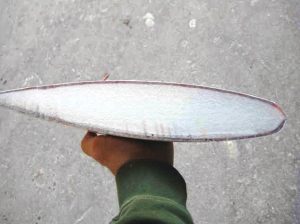
A cross section of a good rudder made with closed-cell urethane foam.
Onto a truck went our mess of a fin, and in a week’s time their shop had it ground down and cut open. It was no surprise when the first email came across my screen and the opening line read, “Your rudder is hollow inside! It is also very wet.” Sigh.
By a stroke of good luck, our existing stainless steel rudder stock was in good shape and they were able to salvage and weld it to accommodate the new blade. The process of building a new rudder started by creating a mold for each side, laying up the fiberglass, and fitting and glassing the new rudder stock and flange in place. Next, they filled the rudder with 20-pound per cubic foot closed-cell urethane foam and the whole thing was clamped together. After coming out of the mold, it got a trim before they glassed the seams, faired it down, and then gelcoated the whole thing.
I received images of our rudder throughout the build process, and it was an interesting procedure to watch unfold. In total, shipping and building the rudder took slightly over three weeks, and when the new one arrived back in Seattle, it felt like Christmas morning. Ethan met me at the boatyard and together we unwrapped the new beauty and did a dry fit to see how she looked. Gorgeous.
He took it from there, and after applying an epoxy barrier coat and bottom paint, the new rudder and freshly repaired skeg had Yahtzee up and running again far better than when she hit the water in 1984. My goal had been achieved. I was a happy sailor.
The Feeding and Care of a Rudder
In going through this ordeal with our rudder, I tried to learn about what went wrong, where it went wrong, and how to keep it from happening again. In doing so, I sought the advice of several seasoned fiberglass professionals and experts. The first question I posed to all of them was about the warning signs that a rudder has gone or is going bad. What had we missed?

The first dry fit of the new blade showed a near perfect fit.
They all agreed on the warning signs, It is a bad sign if you notice rust-colored water dripping out of the rudder. Most older boat manufacturers used mild steel in the rudder core/shaft system. Rustcolored water dripping out of the rudder can be a sign of corrosion. This corrosion can cause the rudder’s internal plate to break away from the shaft. An early sign of this happening is that the rudder moves on the shaft.
Secondly, it is a good idea to sound out the rudder whenever the boat is hauled. Use a small hammer or even a screwdriver handle to tap over the entire surface of both sides of the rudder. In the areas where the glass is well bonded, there will be a pinging sound. In the areas where the fiberglass is delaminated, it will make a thud sound. Delaminated areas should be cut out, dried, and re-fiberglassed.
I then wondered what steps sailboat owners can take to ensure their rudders are properly maintained. For instance, how often should a rudder be dropped and serviced?
It is recommended that your rudder be dropped (with the steering loosened, which allows the rudder to slide down) every time the boat’s bottom is painted. You only need to lower it a few inches so you can inspect the top of the rudder and area around the shaft. Keep an eye out for electrolysis and crevice corrosion, which usually occur right where the shaft exits the rudder. If your rudder has a groove at the shaft/rudder intersection, consider sealing it with 5200 for a watertight seal.
One of my big quandaries throughout our ordeal was how long water had been in our rudder and what I could have done had I known about it sooner.
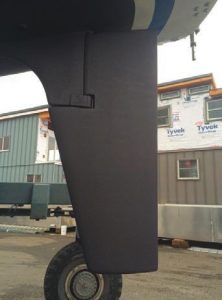
Fully installed, Yahtzee’s new rudder and bottom are ready for splash day.
What I came to learn is that the only place water can hide in rudders is between the fiberglass and the foam in an area that is delaminated. Old rudders like Yahtzee’s are typically built with outdated and inferior core materials that can be very difficult to dry out, thus making water intrusion a significant problem.
In general, the lower-density foams that some manufacturers use inside their rudders, such as 2- and 4-pound foam, are nearly impossible to dry out once the entire core becomes saturated. You should drill an inspection hole to determine the core material used in your rudder and what condition it is in, then take steps to repair and fill it with the appropriate material.
Looking Toward the Horizon
For boat owners now wondering about their own rudder, it might pay to have a professional take a thorough look at it next time you haul out. Though the warning signs for our rudder issues were minimal, it did take some exploratory grinding to reveal the cause of the problem. Part of me wishes that we’d dropped the rudder sooner and gone through it with a finetooth comb. That said, finding and fixing rudder problems isn’t easy, and no two problems are exactly alike. In the end, it’s a matter of figuring out what you’ve got hanging from your stern.
Another key point prudent sailors need to consider, especially those who are heading offshore or even sailing coastally, is what you would do if you lost your rudder at sea. How would you steer? What equipment do you have aboard to help you get back to port? Have you used it? One bright spot in all this for us is that we have a Hydrovane self-steering unit fitted on Yahtzee’s stern, and in the event of a rudder loss or failure, its rudder would act as a perfectly capable backup that could steer the boat thousands of ocean miles.
While the overall experience of fixing our skeg and finding our bad rudder and then going through the process of getting a new one wasn’t something I’d wish upon any sailor, it certainly was a learning opportunity. And now that everything is fixed to a standard far better than when we bought the boat, we’re sailing away with peace of mind that we took care of our rudder and now it’s taking care of us, and that’s priceless.
Andy Cross is the editor of Good Old Boat. The Yahtzee crew is currently cruising the Caribbean and their adventures can be followed at SailingYahtzee.com.
Thank you to Sailrite Enterprises, Inc., for providing free access to back issues of Good Old Boat through intellectual property rights. Sailrite.com

